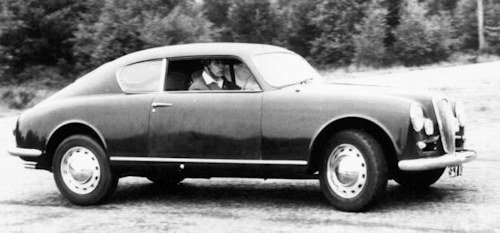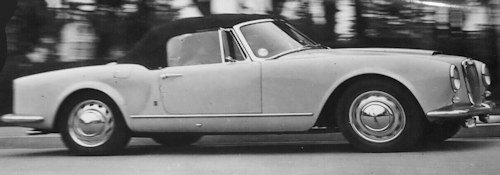Lancia Aurelia
 | |
Production period: | 1950 to 1958 |
Class : | motor car |
Body versions : | Saloon , Coupé ,Cabriolet |
Engines: | Gasoline : 1.75-2.5 liters (42-113 kW) |
Length: | 4420 mm |
Width: | 1560 mm |
Height: | 1500 mm |
Wheelbase : | 2860 mm |
Curb weight : | 1080 kg |
The Aurelia is a model of the Italian car from the 1950s by Lancia , which was produced from 1950 to 1958.
History
At the Turin Motor Show, inaugurated on May 4, 1950 , all Aurelias was exhibited, the B10 sedan , characterized by a harmoniously rounded line, a Front-engine, rear-wheel-drive car with 1.8-liter 6-cylinder V -engine and a load-bearing body with suspensions with four independent wheels, from the clutch-gearbox-differential unit arranged at the rear .A year later, in the spring of 1951 , the engine made its debut with a displacement increased to 2 liters, which was mounted on the brand new sleek and sporty B20 coupé and, as an alternative to the 1.8-liter, on the sedan, which took the name of B21 . Even the chassis for the body builders are fitted with the two-liter engine and take on the new abbreviations B52 and B53 .
During 1952 , the Aurelia range presented three innovations: the second series of the B20 coupé (slightly enhanced and modified in some bodywork details), a new elongated 6-7 seater representative limousine (type B15 ) and, in autumn, a new version of the sedan ( B22 ) also designed as a function of participation in racing in the touring category.1953 , saw a profound renewal of the B20 coupé , whose performance, thanks to the increase in displacement to 2.5 liters, .
In 1954 it was the turn of the sedan, whose second series (or type B12 ) was exhibited at the Turin Spring Show: this new series, more luxuriously finished, loses its sporting characteristics, undergoes an increase in displacement (which now rises to 2.3 liters), while the rear independent wheel suspension is replaced by the so-called De Dion bridge : this second series replaces the previous B10, B21 and B22 in one fell swoop. Naturally, even the chassis for coachbuilders - now quantitatively almost irrelevant - adopt the 2.3-liter engine and take the abbreviations B55 and B56. Practically simultaneously with the release of the second sedan series, the B20 coupé is also modified, showing better finishes and above all the adoption of the De Dion-type rear axle.
At the end of the year, the production of the B24 spider began (later called "America" as it was designed and created above all with the aim of that overseas market) which essentially has the 2.5-liter mechanics of the B20 and which makes its official debut at Brussels Motor Show of January 1955 .
In 1956 , after the transfer of ownership of Lancia , while the production of the sedan came to an end (the new flagship of the Lancia house, the B20 coupé continued to be built, albeit in limited quantities. and the B24s , which in turn are transformed from spiders into more comfortable convertible-cabriolet . The latest B20 and B24 left the factory in the second half of 1958

The Aurelia was available with various engine and body variants (sedan, coupe and convertible). With this vehicle, Lancia was innovative: It had the first produced in a well-known series V6 engine, this was also one of the first car engines with housing and cylinder head made of light metal. At the beginning of the engine had 1754 cc displacement (bore 70 mm and 76 mm stroke) with a maximum power of 42 kW (56 hp) at 4000 / min, later there were up to 2.5 l and 113 kW in the coupe. The engines had staggered crankpins, wet liners and a central chain driven camshaft with hydraulic tensioner. The hanging valves were operated by rocker arms and were V-shaped because of the hemispherical combustion chambers.
Clutch, transmission and differential were united in one housing ( Transaxle) and on the rear axle together with the internal drum brakes. As a result, the axle loads were approximately equal. The front wheels were as with the predecessor Aprilia individually suspended with sliding sleeves (similar to Morgan ), behind there was first the first trailing arm axle at all, in the fourth series from 1954 then a De Dion rigid axle . The Aurelia was one of the first cars with radial tires (165 × 400).
The Aurelia was designed by the designer Vittorio Jano . The car was for Lancia above all an economic success, but was also stylistic for many more Lancia models. In addition, Lancia began this series of success in rallying with this model .
Based on the Aurelia was born in 1956, the Lancia Florida as a study of the introduced in the spring of 1957 successor Lancia Flaminia .
Models and quantities:
- Aurelia B10 / B15 / B21 / B22 / B12 (sedan on different wheelbase, 1950-1954) 13,677 pieces
- Aurelia B50 / B51 / B52 / B55 / B56 / B60 (chassis only): 783
- Aurelia B20 GT (Coupé, 1951-1958) 3111 pieces
- Aurelia B24 Spider (1955) 240 pieces
- Aurelia B24 Convertibile (1955-1958) 521 pieces



